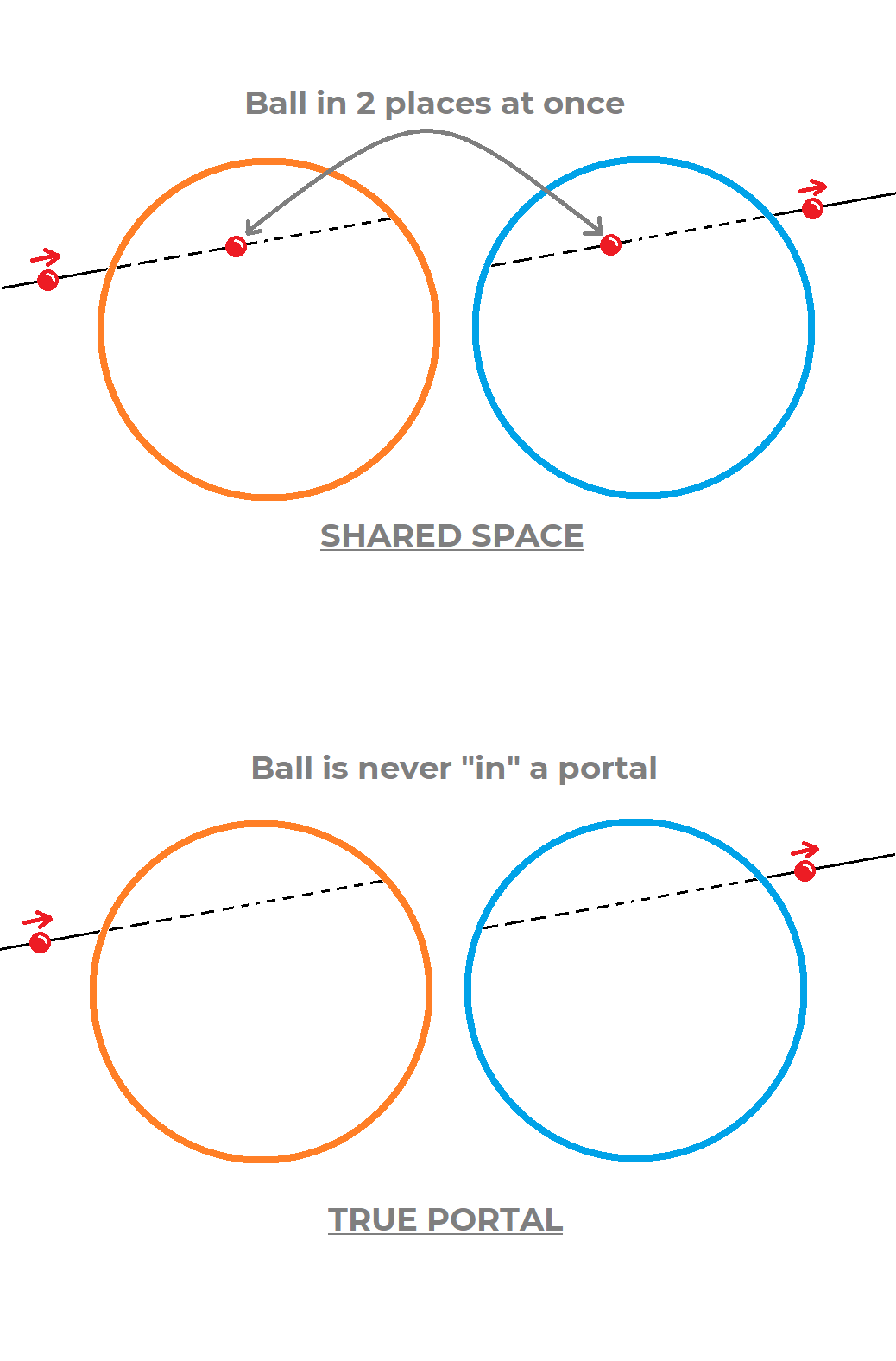Whilst popularly presented as 2D windows into space, this presentation has... issues, some of which I delved into in Part 1. In this part I take the common understandings of how portals might work and reverse engineer what they would probably look like.
To start with, let's first establish some sensible axioms that must be true about portals for them to exist as we commonly understand them.
- Space is continuous across the portals
- There are no discontinuities in physical space across the portal
- Environments can differ on either side but there is constant capacity for movement between them at all times
- I could stick my arm through and pull it back without it being separated or otherwise harmed by passing through
- There is no space "between" the portals.
- Two portals completely overlapping would be indistinguishable from normal space
- You could pass through without knowing you had travelled through a portal
- As many of the laws of physics as possible must be untouched
In other words, the least-reality-breaking interpretation will be the superior one! The first thing to think about is that a portal in 3D space, will itself be 3D.
As so succinctly explained in Interstellar, real portals are probably going to be 3D in 3D space rather than 2D. The classic example is to take a piece of paper, fold it over and then cut a hole in the two ends at the same place (usually someone punches a pen through the paper). From the surface of the paper in 2D you can not tell that your existence was just folded in a 3rd dimension. You are unable to comprehend a 3rd dimension so you can not perceive it, but you can see the hole, which will be a circle. We similarly can't comprehend or perceive a 4th dimension but we would be able to perceive the hole, and a circle in 3D is a sphere!
Portals being spheres immediately solves a lot of the problems we encountered earlier, although their appearance is significantly harder to imagine, conceptually.
- There is no "back" side
- There is no "edge"
- We have no preconceived notions of portals existing "on" something
- These portals get to be "fixed" in space, or at least not arbitrarily dependent on physical matter!
The best image of what a portal might look like, comes from Interstellar, seen below and they look.. odd.
How would matter pass through a spherical portal
So, there are 2 options here that I logically thought of, but potentially many more.
- The portals are holes in space (the best option I think)
- The portals share a portion of space (less likely but easier to program)
Regarding option 1, Jeremy Thille has an excellent video on the topic of the paradox on YouTube, which demonstrates this perfectly. Jeremy Thille - Portal theory: paradoxes are invalid - feat. Nonmario. Portals are not two things (as we frequently refer to them as), but a single 'gateway' between two sections of space that have been folded together in a fourth dimension and our "portals" are the separate "sides" of the gateway in the 3D space we can see. This gateway is thus "anchored" by the space it is in. Jeremy concludes that because of this fact that portals can't move the paradox can't exist. However, this is where I disagree with Jeremy's conclusion. There is no such thing as a fixed point in space and the way he describes it would mean that there would be one. Except space can deform and move, so in principle a gateway could still move in space because the space itself could move. Not to mention the fact that a General Relativity wormhole would be a warped hole in space, necessarily deforming reality around itself into another dimension.
I came up with option 2 whilst writing this article and think it also merits thought. In order to investigate the various things going on with portals in this problem I decided to code up a simple simulation to look at the possibilities and also help doing some visualisation. I stuck to 2D for ease, but even then coding the portal interactions was particularly challenging. In 2D, with circular portals, it necessitates calculating the chord across the circles to predict where something entering the portal would exit and I just didn't have time for this. Instead, I thought "well what if the portals actually share space and when you enter a portal you're actually entering a region of shared space and when you leave the space you can leave by one of the two 'sides'?". It's an interesting thought and much easier to program. Though it has its problems, like how would you choose which space you exit into? The portal could know which you enter from and force you to leave by the other perhaps? Although I don't know how you would know. This scenario looks almost identical to option 1 when implemented and is a lot easier to program. It also casually solves a few classic portal issues with ease, including the portal crushing issue. If two portals of this style were smashed together then the space would overlap and space would "fix" itself. The hole would close and normal service would resume. It's quite neat actually!

Ultimately, however, it should be clear that portals in some capacity, are hypothetical and are technically allowed under General Relativity. So, realistic portals will necessarily break as few physical laws as possible since a "real" portal wouldn't break any as it would exist. This is actually an argument that portals/wormholes could never exist, and this aspect of General Relativity is incomplete.
Other Articles in this Series
The next article covers the theory behind the portal paradox. If you want to read the whole series you can find links to all the articles here: